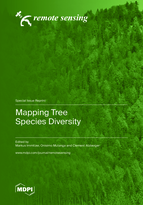Mapping Tree Species Diversity
A special issue of Remote Sensing (ISSN 2072-4292). This special issue belongs to the section "Forest Remote Sensing".
Deadline for manuscript submissions: closed (15 December 2021) | Viewed by 91736
Special Issue Editors
Interests: remote sensing based on optical data with high to very high spatial and spectral resolution for forest mapping; vegetation stress monitoring; modeling of biophysical parameters; and land cover classification—focus on temperate forests
Interests: remote sensing; land use; environment; vegetation; hyperspectral remote sensing; ecosystem ecology; spatial analysis; climate change impact analysist; vegetation mapping
Special Issues, Collections and Topics in MDPI journals
Interests: remote sensing of vegetation with focus on time series analysis and use of physically based radiative transfer models for mapping biochemical and biophysical traits
Special Issues, Collections and Topics in MDPI journals
Special Issue Information
Dear Colleagues,
The current UN report on Biodiversity and Ecosystem Services depicts an alarming and shocking picture of the Earth. With accelerating rates of species extinction, our environment is declining globally at unprecedented rates. Transformative economic and societal change is necessary, and will involve far-reaching alterations in thoughts and actions at both local and global levels. To cope with the pace of global change, a rapid increase in knowledge about species numbers, compositions, and conditions is required, as well as species interactions and environments. Remote sensing provides the only feasible way to cost-effectively and repeatedly measure and monitor these changes. Today’s satellite, aircraft, and UAV instruments provide a wide range of observational capability in terms of spatial, temporal, and spectral resolutions. Machine learning approaches and computational capacity are improving quickly, offering huge potential for improved data analysis, including “big data” and the development of powerful monitoring systems.
This Special Issue will include studies focused on the remote observation of spatial patterns and temporal changes in the biodiversity of forests, at local to global scales. We invite authors to submit recent research that specifically addresses the detection or monitoring of
- biodiversity of forests in the context of classical species diversity;
- the mapping of changes in diversity;
- the floristic composition of forests;
- invasive species; and
- the functional diversity of forests.
Review articles are also welcome.
Dr. Markus Immitzer
Prof. Dr. Onisimo Mutanga
Prof. Dr. Clement Atzberger
Guest Editors
Manuscript Submission Information
Manuscripts should be submitted online at www.mdpi.com by registering and logging in to this website. Once you are registered, click here to go to the submission form. Manuscripts can be submitted until the deadline. All submissions that pass pre-check are peer-reviewed. Accepted papers will be published continuously in the journal (as soon as accepted) and will be listed together on the special issue website. Research articles, review articles as well as short communications are invited. For planned papers, a title and short abstract (about 100 words) can be sent to the Editorial Office for announcement on this website.
Submitted manuscripts should not have been published previously, nor be under consideration for publication elsewhere (except conference proceedings papers). All manuscripts are thoroughly refereed through a single-blind peer-review process. A guide for authors and other relevant information for submission of manuscripts is available on the Instructions for Authors page. Remote Sensing is an international peer-reviewed open access semimonthly journal published by MDPI.
Please visit the Instructions for Authors page before submitting a manuscript. The Article Processing Charge (APC) for publication in this open access journal is 2700 CHF (Swiss Francs). Submitted papers should be well formatted and use good English. Authors may use MDPI's English editing service prior to publication or during author revisions.
Keywords
- tree species mapping
- biological diversity
- multispectral optical remote sensing
- hyperspectral optical remote sensing
- synthetic aperture radar
- multi-temporal remote sensing
- satellites, aircraft, UAVs
- sensor fusion








